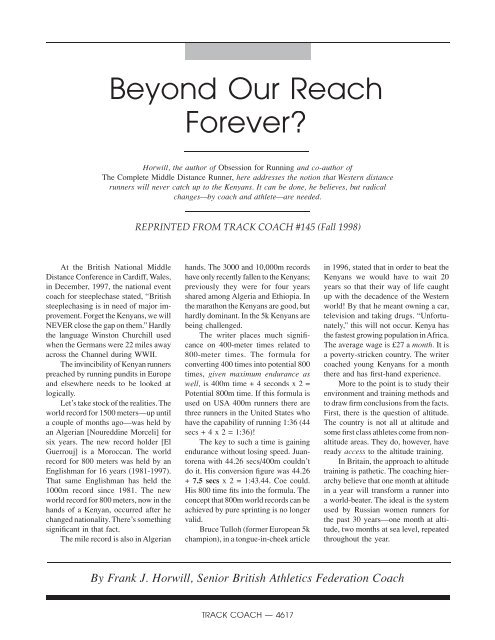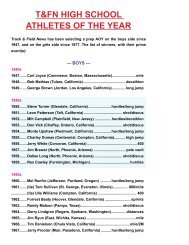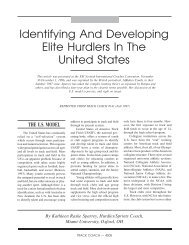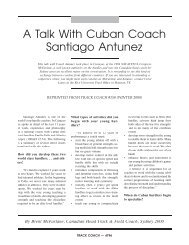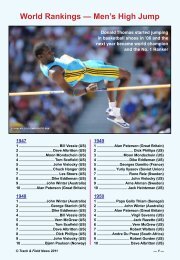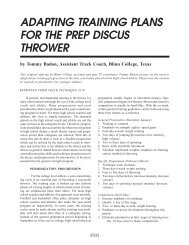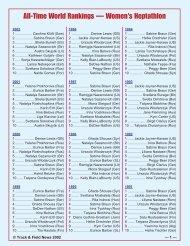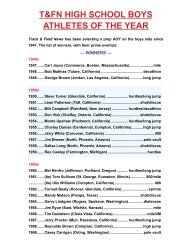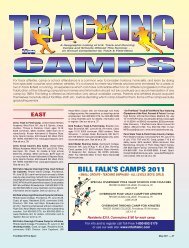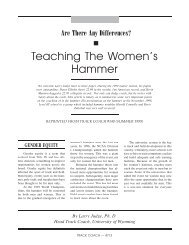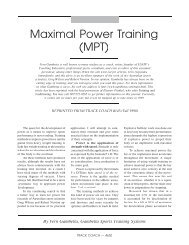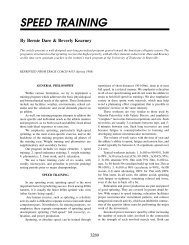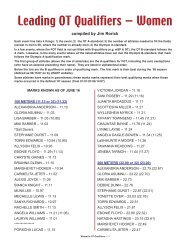Beyond Our Reach Forever? - Track & Field News
Beyond Our Reach Forever? - Track & Field News
Beyond Our Reach Forever? - Track & Field News
Create successful ePaper yourself
Turn your PDF publications into a flip-book with our unique Google optimized e-Paper software.
<strong>Beyond</strong> <strong>Our</strong> <strong>Reach</strong><br />
<strong>Forever</strong>?<br />
Horwill, the author of Obsession for Running and co-author of<br />
The Complete Middle Distance Runner, here addresses the notion that Western distance<br />
runners will never catch up to the Kenyans. It can be done, he believes, but radical<br />
changes—by coach and athlete—are needed.<br />
REPRINTED FROM TRACK COACH #145 (Fall 1998)<br />
At the British National Middle<br />
Distance Conference in Cardiff, Wales,<br />
in December, 1997, the national event<br />
coach for steeplechase stated, “British<br />
steeplechasing is in need of major improvement.<br />
Forget the Kenyans, we will<br />
NEVER close the gap on them.” Hardly<br />
the language Winston Churchill used<br />
when the Germans were 22 miles away<br />
across the Channel during WWII.<br />
The invincibility of Kenyan runners<br />
preached by running pundits in Europe<br />
and elsewhere needs to be looked at<br />
logically.<br />
Let’s take stock of the realities. The<br />
world record for 1500 meters—up until<br />
a couple of months ago—was held by<br />
an Algerian [Noureddine Morceli] for<br />
six years. The new record holder [El<br />
Guerrouj] is a Moroccan. The world<br />
record for 800 meters was held by an<br />
Englishman for 16 years (1981-1997).<br />
That same Englishman has held the<br />
1000m record since 1981. The new<br />
world record for 800 meters, now in the<br />
hands of a Kenyan, occurred after he<br />
changed nationality. There’s something<br />
significant in that fact.<br />
The mile record is also in Algerian<br />
hands. The 3000 and 10,000m records<br />
have only recently fallen to the Kenyans;<br />
previously they were for four years<br />
shared among Algeria and Ethiopia. In<br />
the marathon the Kenyans are good, but<br />
hardly dominant. In the 5k Kenyans are<br />
being challenged.<br />
The writer places much significance<br />
on 400-meter times related to<br />
800-meter times. The formula for<br />
converting 400 times into potential 800<br />
times, given maximum endurance as<br />
well, is 400m time + 4 seconds x 2 =<br />
Potential 800m time. If this formula is<br />
used on USA 400m runners there are<br />
three runners in the United States who<br />
have the capability of running 1:36 (44<br />
secs + 4 x 2 = 1:36)!<br />
The key to such a time is gaining<br />
endurance without losing speed. Juantorena<br />
with 44.26 secs/400m couldn’t<br />
do it. His conversion figure was 44.26<br />
+ 7.5 secs x 2 = 1:43.44. Coe could.<br />
His 800 time fits into the formula. The<br />
concept that 800m world records can be<br />
achieved by pure sprinting is no longer<br />
valid.<br />
Bruce Tulloh (former European 5k<br />
champion), in a tongue-in-cheek article<br />
in 1996, stated that in order to beat the<br />
Kenyans we would have to wait 20<br />
years so that their way of life caught<br />
up with the decadence of the Western<br />
world! By that he meant owning a car,<br />
television and taking drugs. “Unfortunately,”<br />
this will not occur. Kenya has<br />
the fastest growing population in Africa.<br />
The average wage is £27 a month. It is<br />
a poverty-stricken country. The writer<br />
coached young Kenyans for a month<br />
there and has first-hand experience.<br />
More to the point is to study their<br />
environment and training methods and<br />
to draw firm conclusions from the facts.<br />
First, there is the question of altitude.<br />
The country is not all at altitude and<br />
some first class athletes come from nonaltitude<br />
areas. They do, however, have<br />
ready access to the altitude training.<br />
In Britain, the approach to altitude<br />
training is pathetic. The coaching hierarchy<br />
believe that one month at altitude<br />
in a year will transform a runner into<br />
a world-beater. The ideal is the system<br />
used by Russian women runners for<br />
the past 30 years—one month at altitude,<br />
two months at sea level, repeated<br />
throughout the year.<br />
By Frank J. Horwill, Senior British Athletics Federation Coach<br />
TRACK COACH — 4617
How to adapt to altitude training<br />
and when to come down before major<br />
competition are worthy subjects for an<br />
article in their own right. One major<br />
error is the belief that no race pace<br />
work can be done. This is not so. If<br />
a 28-minute 10k runner (67 secs/400)<br />
were to go to altitude he would certainly<br />
have difficulty doing repetition miles in<br />
4:28 with 45 secs recovery. However, he<br />
can do 25 x 400 in 67 secs with 30 secs<br />
recovery. Never to train at a race pace<br />
at all at altitude is a foolhardy practice<br />
and it will be noticed in performances<br />
at sea level on return.<br />
Two work physiologists have studied<br />
Kenyan runners in detail—Saltin<br />
(Sweden) and Noakes (South Africa).<br />
Their findings should be posted in every<br />
track & field department in universities<br />
and in athletics clubhouses. Briefly, their<br />
conclusions were:<br />
1. Many Kenyans (14-17 years) run at<br />
least six miles a day, some double<br />
that. This is of necessity to get<br />
to school or home, since public<br />
transport is rudimentary or nonexistent.<br />
2. In high school, a further six miles of<br />
running is done on top of that to get<br />
to and from school. Of this six miles,<br />
half is done at 5k speed—that’s 95%<br />
VO2max. Steady running can be between<br />
60 to 75% VO2max. There is<br />
no talk of lactate threshold running<br />
here! That sort of running for a 9<br />
minutes 2-miler would be 4:53/mile<br />
for 4 miles, and for an 11 minutes<br />
2-miler, 6:13/mile. These boys are<br />
running considerably faster than this<br />
from an early age.<br />
The other significant point is that<br />
the world’s leading work physiologists—Astrand,<br />
Costill, Saltin<br />
and Noakes—state that work at an<br />
athlete’s 5k speed is the greatest<br />
boost to the VO2max in the book.<br />
However, Russian women prefer<br />
continual exposure to 3k speed<br />
(100% VO2max). So, from a very<br />
early age Kenyan boys are increasing<br />
their VO2max.<br />
3. The Kenyan boys also kill two<br />
birds with one stone! The volume of<br />
training also improves the VO2max.<br />
Any runner who starts off with 30<br />
minutes of steady running a day and<br />
increases it by 5 minutes a day per<br />
week to 60 minutes (12 weeks later)<br />
will improve his VO2max by 10%,<br />
and if he continues in that fashion<br />
to 1 1/ 2 hours a day, he will improve<br />
a further 5%. After this (about 80<br />
miles), improvement in the VO2max<br />
rapidly tapers off. They must either<br />
make the 80 miles plus faster, or<br />
some of the 80 miles faster. It will<br />
be noted that the Kenyans at school<br />
are doing the latter.<br />
4. When it comes to the proportion<br />
of aerobic work and fast aerobic<br />
running in adult Kenyan runners<br />
compared to Western runners, it is<br />
clear that the latter are way behind<br />
in a year’s calculations. Fast aerobic<br />
running is that which is done between<br />
80 to 100% of the VO2max.<br />
Or—put another way—half-marathon<br />
speed through to 2-mile speed.<br />
The Kenyans devote one-third of<br />
their running to this work. Western<br />
runners devote a mere 10%. So, a<br />
Western runner who covers ten miles<br />
a day, six days a week—a total of<br />
3,120 miles annually—will only<br />
do 312 miles of fast aerobic work,<br />
while his Kenyan counterpart will be<br />
doing 936 miles in the 80 to 100%<br />
VO2max zone. Little wonder that the<br />
Kenyans at present are superior!<br />
5. The findings in (4) are confirmed<br />
by muscle biopsies carried out by<br />
Saltin on leading Kenyan runners.<br />
He found that in the thigh (rectus<br />
femoris) they contained the greatest<br />
amount of aerobic enzyme he had<br />
ever seen. And he’s seen a good<br />
many world-class runners in his<br />
time. This meant that they could<br />
alter pace without tiring easily. He<br />
also thought that daily exposure to<br />
undulating terrain contributed to<br />
this condition.<br />
6. The height/body ratio of Kenyan<br />
runners was superior to Caucasian<br />
runners. Give two athletes six feet<br />
tall, the Kenyan would weight 142<br />
lbs. on average, while Caucasian<br />
runners weighed 159 lbs. That extra<br />
17 lbs. will take its toll in any<br />
race beyond a mile. The weight<br />
difference is probably due to the<br />
faster proportion of running using<br />
up more calories and to their diet<br />
which is higher in fruit, vegetables<br />
and carbohydrates, and lower in<br />
meat than Caucasian runners.<br />
7. Finally, and a big factor, running is<br />
an opportunity to escape poverty.<br />
For every great Kenyan runner, there<br />
are ten schoolboys waiting to fill his<br />
shoes.<br />
So, what’s the bottom line? Many<br />
Western coaches are loath to change<br />
their ways. We have in England coaches<br />
who believe that trotting around the<br />
countryside in the winter, notching up<br />
100 miles a week, is going to make<br />
a great cross country runner. Great<br />
Britain’s results in the last World Cross<br />
Country Championships were the worst<br />
for a decade in the men’s division.<br />
We also have coaches who believe<br />
that young athletes should never exceed<br />
four miles a day up to the age of 18<br />
years. This seems to be a standard more<br />
or less approved of officially, because<br />
Great Britain does not have entrants in<br />
the World Junior Championships 10k,<br />
while some Kenyan juniors are recording<br />
world-class times at that age.<br />
The British coaching examination<br />
places great emphasis on periodization.<br />
There isn’t a world-class runner who<br />
adheres to periodization in its original<br />
form. When the writer spoke to a leading<br />
Kenyan about microcycles, macrocycles<br />
and mesocycles, he thought the subject<br />
was about new Japanese motorcycles!<br />
Invented by a Russian, period-ization<br />
has failed to produce a truly worldclass<br />
performer in the men’s division for<br />
a long time. Periodization is basically<br />
aimed at one peak performance. No<br />
top-class runner can afford one peak in<br />
a year. It’s dead, and should be buried.<br />
It’s results that count, and periodization<br />
has not brought results in Britain—in<br />
fact, the opposite.<br />
Now, let’s clarify this VO2max percentage<br />
business. If a runner has never<br />
raced 3k, 5k, 10k or the half-marathon,<br />
how does he know what speeds to train<br />
at? Well, a starting point is to take the<br />
1500m time per 400m and keep add-<br />
TRACK COACH — 4618
ing 4 seconds per 400 meters for each<br />
increasing distance. See table below.<br />
Here are typical Kenyan sessions at<br />
those speeds based on 4 mins/1500m:<br />
• 3k—3x1500 meters at 68<br />
secs/400 with 3 mins recovery.<br />
• 5k—6x1,000 meters at 72<br />
secs/400 with 60 secs recovery.<br />
• 10k—4x2 miles at 76 secs/400<br />
with 90 secs recovery.<br />
• Half-Marathon—Either run<br />
13 miles at 5:20/mile or 4x4<br />
miles at 5:20/mile with 90 secs<br />
recovery.<br />
Looks tough? It is! Don’t expect<br />
to register the times on first, second<br />
or third outings. Usually it’s the sixth<br />
effort which brings rewards. And don’t<br />
take longer recoveries to register the<br />
times. Anyone can run fast repetitions<br />
and have a cup of tea and a doughnut<br />
after each repetition! Distance running<br />
revolves around sustained speed.<br />
In 1984 and 1989, the author’s protégé,<br />
Tim Hutchings, won silver medals<br />
in the World Cross Country Championships<br />
training regularly between 80<br />
and 100% of his VO2max using all the<br />
above types of sessions over a 14-day<br />
cycle. In 1989, he defeated all but one<br />
of strong Kenyan team. He spent three<br />
separate months at altitude in Kenya in<br />
one year as part of the preparation. It can<br />
be done again by a Western athlete.<br />
Best 1500 meters 3k/2 miles pace 5k pace 10k pace Half-Marathon<br />
4 mins (64 secs/400) 68 secs/400 72 secs/400 76 secs/400 80 secs/400<br />
TRACK COACH — 4619


